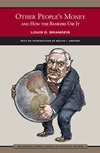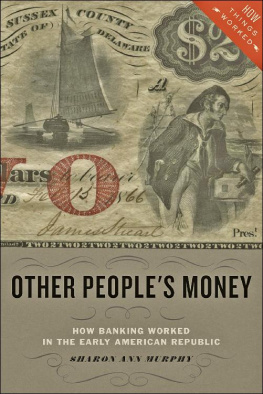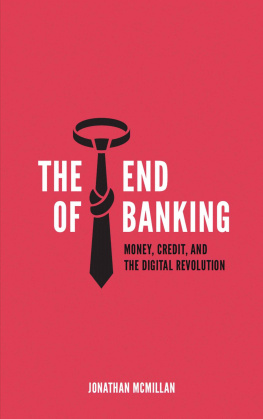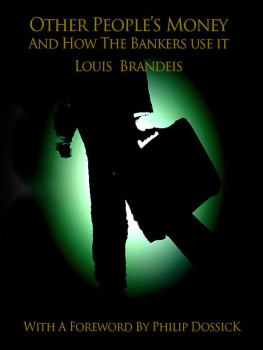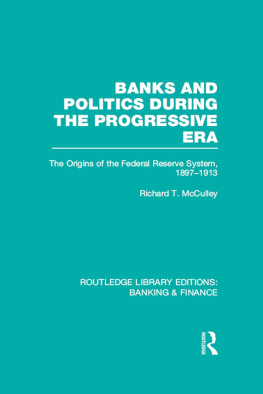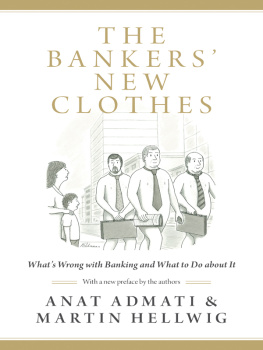OTHER PEOPLE'S MONEY
AND HOW THE BANKERS USE IT
LOUIS D. BRANDEIS
I NTRODUCTION BY M ELVIN I. U ROFSKY

Introduction and Suggested Reading
2009 by Barnes & Noble, Inc.
This 2011 edition published by Barnes & Noble, Inc.
All rights reserved. No part of this publication may be reproduced, stored in a retrieval system, or transmitted, in any form or by any means, electronic, mechanical, photocopying, recording, or otherwise, without prior written permission from the publisher.
Barnes & Noble, Inc.
122 Fifth Avenue
New York, NY 10011
ISBN: 978-1-4114-3502-5
I NTRODUCTION
T HERE ARE FEW INDICTMENTS OF THE A MERICAN BANKING SYSTEM AS searing as Other People's Money and How the Bankers Use It, written by Louis D. Brandeis in 1913. Long considered one of the major muckraking exposs of the Progressive period, it still speaks powerfully to our own times. The book led to the establishment of stringent regulations on the banking system, rules that undergirded decades of prosperity and stability for both banks and the American economy after World War II. Weakening those rules led to the great banking meltdown of 2008, when once again the greed and recklessness that Brandeis had warned about triggered a major depression and cost hundreds of thousands of people their jobs and homes.
Louis Dembitz Brandeis (18561941) is known to most people as one of the giants of American constitutional law who, as a justice on the U.S. Supreme Court from 1916 to 1939, played a key role in developing the jurisprudence that is the foundation of the modern interpretation of the Constitution and the rights it guarantees. But before then, contemporaries hailed him as one of the nation's leading reformers, the "People's Attorney" who used his formidable legal talents in the public service. Among Progressives he led the attack against monopolies and what he termed the "curse of bigness," charging that the large banks, headed by J. P. Morgan, had created a money trust. In 1912 a congressional committee held extensive hearings that uncovered how those banks used their financial power to dominate American industry. Brandeis took these revelations and interpreted them in popular language, first in a series of articles in Harper's Magazine, and then in book form.
There are two ways to read Other People's Money. One is to focus on the financial ploys used by bankers to stifle competition and to control businesses who relied on the banks for credit. These devices included interlocking directorates, where the price of getting credit included seats for the bankers on corporate boards, and control of stock issues, with large profits derived from both the sale of securities and the money to finance those sales. The reader may be forgiven if he or she thinks that the stratagems unveiled by Brandeis seem simple compared to the intricacies of securitized mortgages and credit swap deals, but the theme is the samehow bankers, using the money of their depositors, exploit their control over the money supply to secure great profits at the expense of a competitive market and of the political system.
The second way is to realize that for Brandeis and for most Americans of his generation, the marketplace carried not only economic but social and indeed moral implications. The book speaks to thosethen and nowwho believe that success in one's chosen field, whatever that field may be, may lead to financial reward but more importantly it will be a validation of the person's character. Success allows a person to provide for his or her family, perhaps purchase a house and educate one's children. When the banks use their power to stifle competition, when they choke off credit to those seeking to establish new businesses, when they stack the deck to help only those companies in which they have a vested interest, then it is not only the market but society that suffers as well. And if in their greed they overreach and help pull the economic system down, as they did in the 1920s and in the first decade of the twenty-first century, then the loss of jobs, homes, and opportunities have enormous social and political as well as economic repercussions.
The book, therefore, is about power and its abuses, and while the manner of those abuses has changed over the last century, the essential message that Brandeis preached remains the same. When there is great power in private hands, such as the concentration of capital in a handful of banks, those who control that power will use it to enrich themselves at the expense of the public good, and the results will not only adversely affect individuals, but could well have catastrophic effects on society, the economy, and on government itself.
Bankers and their spokesmen denigrated Brandeis for his alleged ignorance of how the financial system worked. He had, however, been a successful commercial lawyer in Boston for more than thirty years, and through his clients come to know and understand not only how the credit market operated, but also how the power brokers had. Reformers, and especially President Woodrow Wilson, took the warnings of Other People's Money seriously, and Wilson and his advisors relied on Brandeis' recommendations when they drew up the Federal Reserve Act of 1913. It was a beginning, and like many first efforts had its weaknesses, which bankers exploited in the Roaring Twenties. People forgot Brandeis' warnings and paid no attention as banks used their money to fuel stock speculation, making money both from the loans they made as well as commissions from stock transactions made through their brokerage units. The house of cards they created came crashing down in the fall of 1929, and in March 1933 state governments closed nearly every bank in the country as depositors waited in long lines to withdraw their money.
Brandeis agreed to a new edition of Other People's Money in the depths of the Great Depression, and Franklin D. Roosevelt, like Wilson before him, heeded the book's advice as the New Deal imposed stricter regulations on the banking system and forced the separation of banking and stock brokerage operations.
In the years after the Second World War, American commercial banking operated under a system of rules which certainly did not prevent individual banks from making moneyquite a bit of itbut which did prevent them from exploiting their financial power. In the 1960s and 1970s federal law forced banks to provide credit to women and minorities, allowing them to start businesses and participate in the nation's prosperity.
Starting in the 1980s, however, there were danger signs. A new financial device, the so-called "junk bond," seemed to offer large rewards at low risk, and many of the nation's savings banks, which operated under a different set of rules from commercial banks, over-invested in these worthless pieces of paper. The federal government was forced to intervene in order to save depositors' money.
When Ronald Reagan started preaching that government regulation was throttling American enterprise, no voices were louder in his support than the commercial bankers. The regulations that went back more than five decades were too "restrictive," they "hamstrung" American banks that now had to compete in a world market against European and Japanese banks that had no such fetters on them. Congress responded by easing regulations, and before long banks were once again able to establish brokerage units. Stories again began circulating how analysts in these offices plugged stocks of companies that just happened to be financed by their parent banks. New and intricate financial instruments such as derivatives that were free of traditional rules regarding transparency and information requirements began to trade, as did securitized mortgages and other devices that most investors knew nothing about.

